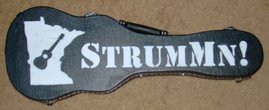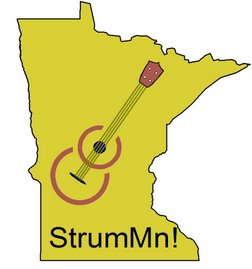Having only received a few replies I've made " an executive decision! "
DAMN THE TORPEDOES! FULL SPEED AHEAD!
I've told the folks from California that will be visiting Minnesota that we'll go ahead with both dates in April, 6th&13th, and hope to see them at Como.
2-5pm both dates.
I also hope to see ALL of you there; although I expect, and will have to be happy if, only a couple show up...
Saturday, March 15, 2008
Friday, March 07, 2008
Playing Old Music
Or maybe I could more accurately title this "Playing From Old Music".Last Sunday for those who showed up I passed out a copy of the song Dream A Little Dream Of Me. I think you've all heard this song done by the Mama's and the Papa's or other versions. The version I handed out was from a 1950 music book and included ukulele chords. I've got it saved as a pdf file if anyone wants to follow along for education purposes. Dream
To digress for a second, I like picking up old music books from used book stores or off ebay. I don't have a bunch or anything but I've bought a half dozen or so. These have many songs that I'd heard years ago and forgotten about and many that I've never heard of. I look for those with uke chords and arrangements mostly. Many of these old books list alternate tuning than the normal C tuning of GCEA, many are tuned in D (ADF#B) and some are in Bb (FBbDG) or others. The key is not to let that throw you too much and the copy of Dream that I handed out Sunday is an example of that.
My copy of Dream is written out in D tuning, ADF#B, and I got comments like " do I need to retune my uke" and "how do I play this?" When you hit these at home by yourself you've got a number of options, as you do when you play along with others.
My ukes are all tuned GCEA as are most of yours so these are the options as I see them.
1) You can retune your uke. I've never done this yet and don't see the need. In some ways it would just confuse me, in the long run maybe it would help me understand the fretboard better. I'd not be "locked in" to "5th Fret, 2nd string is A", it could open my mind to look at the tuning relationships rather than absolutes.
2) In this case I could snap a capo on the second fret and play it as written. I'd have effectively moved the nut up 2 half steps and my uke would now be tuned ADF#B. This way all the nice chord boxes are correct but the chord names don't match the shapes you're used to. I have a capo but never use it, maybe some day.
3) Forget the capo, forget retuning. If you're just by yourself you can use the D tuning chord boxes and just play the shapes as noted. The song will sound just fine but you'll be playing in a different key than the song is written. Nothing wrong with this but if you're playing with others then it might cause problems. Try this just so you know it works.
4) This is what I use and what I encouraged others to do on Sunday. Ignore the chord boxes, ignore the tuning. If it says to play a G chord, play the G chord that you know. A "G chord" is a "G chord" no matter what key the song is written in, it always has the same notes. If you play from guitar music or piano music, a G is a G is a G. Don't worry about it.If it says to play F, play F; just don't look at the chord boxes.
If you hit a strange chord in the song you'll need to look it up, right? Well, maybe. In Dream, written for D tuning, if you look at all the chord boxes and add 2 more frets to the top (where the imaginary nut was) and add dots for fretting what were any open strings, you've got the chord you need. For example, 2010 which we all know as an F chord. In Dream a 2010 is a G chord because of the tuning. Add 2 frets (add 2 to each string) to get 4232 which is a sort of second position G. You can see (or figure out) that this gives the notes B D G B and if you dropped the 4 giving 0232 you have the G chord you're used to playing with the notes G D G B. Same notes, doubled-G versus doubled-B, it doesn't make a difference. The point is that in this entire song if you move the chord box pictures up 2 frets you get the chord shapes you know and love, or you learn a second position version of those chords.
Note also that with options 1/2/4 above you're playing the exact same music, 3 people could play each using a different method and it would sound fine. With option 3 you'd be playing the song 2 half steps lower than written. You couldn't play along with others using the other methods but playing alone it will sound just fine.
Everyone thoroughly confused by now? Take a look at the song, play parts of it, ask questions. This stuff gets easier and opens up more options for playing good ol' tunes you might run across (or get tossed at you at a StrumMn meeting :-0 )
Speaking of which, see the post below for info on the next StrumMn meeting!
To digress for a second, I like picking up old music books from used book stores or off ebay. I don't have a bunch or anything but I've bought a half dozen or so. These have many songs that I'd heard years ago and forgotten about and many that I've never heard of. I look for those with uke chords and arrangements mostly. Many of these old books list alternate tuning than the normal C tuning of GCEA, many are tuned in D (ADF#B) and some are in Bb (FBbDG) or others. The key is not to let that throw you too much and the copy of Dream that I handed out Sunday is an example of that.
My copy of Dream is written out in D tuning, ADF#B, and I got comments like " do I need to retune my uke" and "how do I play this?" When you hit these at home by yourself you've got a number of options, as you do when you play along with others.
My ukes are all tuned GCEA as are most of yours so these are the options as I see them.
1) You can retune your uke. I've never done this yet and don't see the need. In some ways it would just confuse me, in the long run maybe it would help me understand the fretboard better. I'd not be "locked in" to "5th Fret, 2nd string is A", it could open my mind to look at the tuning relationships rather than absolutes.
2) In this case I could snap a capo on the second fret and play it as written. I'd have effectively moved the nut up 2 half steps and my uke would now be tuned ADF#B. This way all the nice chord boxes are correct but the chord names don't match the shapes you're used to. I have a capo but never use it, maybe some day.
3) Forget the capo, forget retuning. If you're just by yourself you can use the D tuning chord boxes and just play the shapes as noted. The song will sound just fine but you'll be playing in a different key than the song is written. Nothing wrong with this but if you're playing with others then it might cause problems. Try this just so you know it works.
4) This is what I use and what I encouraged others to do on Sunday. Ignore the chord boxes, ignore the tuning. If it says to play a G chord, play the G chord that you know. A "G chord" is a "G chord" no matter what key the song is written in, it always has the same notes. If you play from guitar music or piano music, a G is a G is a G. Don't worry about it.If it says to play F, play F; just don't look at the chord boxes.
If you hit a strange chord in the song you'll need to look it up, right? Well, maybe. In Dream, written for D tuning, if you look at all the chord boxes and add 2 more frets to the top (where the imaginary nut was) and add dots for fretting what were any open strings, you've got the chord you need. For example, 2010 which we all know as an F chord. In Dream a 2010 is a G chord because of the tuning. Add 2 frets (add 2 to each string) to get 4232 which is a sort of second position G. You can see (or figure out) that this gives the notes B D G B and if you dropped the 4 giving 0232 you have the G chord you're used to playing with the notes G D G B. Same notes, doubled-G versus doubled-B, it doesn't make a difference. The point is that in this entire song if you move the chord box pictures up 2 frets you get the chord shapes you know and love, or you learn a second position version of those chords.
Note also that with options 1/2/4 above you're playing the exact same music, 3 people could play each using a different method and it would sound fine. With option 3 you'd be playing the song 2 half steps lower than written. You couldn't play along with others using the other methods but playing alone it will sound just fine.
Everyone thoroughly confused by now? Take a look at the song, play parts of it, ask questions. This stuff gets easier and opens up more options for playing good ol' tunes you might run across (or get tossed at you at a StrumMn meeting :-0 )
Speaking of which, see the post below for info on the next StrumMn meeting!
Sunday, March 02, 2008
StrumMn together again
A half dozen of us had a great time playing again down at como and we continue to get positive comments from other patrons and employees at the cafe. If you haven't been down there with us yet you should consider coming next month, it's a lot of fun! No, we're not "performing" there, we just pull a few tables together and do our thing, so come join us! We had 2 first timers today, I hope they had fun and come back again.
Next month! Based on input from those attending we're going to meet on Sunday April 13th, Black Bear Crossing Cafe at the Como Pavillion again, 2-5pm.
We're always scrounging for new play-a-long songs so bring a favorite if you can, a few copies work fine, we're ok with sharing.
Put it on your calendar now and plan on attending, I'll see you next month!
Keep StrumMn!
Brian
Next month! Based on input from those attending we're going to meet on Sunday April 13th, Black Bear Crossing Cafe at the Como Pavillion again, 2-5pm.
We're always scrounging for new play-a-long songs so bring a favorite if you can, a few copies work fine, we're ok with sharing.
Put it on your calendar now and plan on attending, I'll see you next month!
Keep StrumMn!
Brian
Subscribe to:
Posts (Atom)


